Physical Address
304 North Cardinal St.
Dorchester Center, MA 02124
![]() Access the accompanying videos for this chapter online. Available on ExpertConsult.com .
Access the accompanying videos for this chapter online. Available on ExpertConsult.com .
The need to obtain diagnostic lung tissue occurs often in infants and children. Disease processes such as interstitial lung disease (ILD), infectious lung disease, and metastatic lung lesions may require histologic examination for diagnosis and treatment. The ability to obtain these specimens thoracoscopically has greatly decreased the morbidity associated with open lung biopsy. Moreover, it may have changed the treatment algorithms to encourage earlier operative intervention to direct therapy.
There is currently a wide variety of indications for thoracoscopic procedures in children, and the number continues to expand with advances and refinements in technology and technique. Thoracoscopy is being used extensively for lung biopsy and wedge resection in cases of ILD and metastatic lesions, as well as for infectious diseases, cavitary lesions, and bullous disease. Thoracoscopy is most useful and applicable when lesions are peripheral and away from hilar structures. The surgeon should carefully document the number and location of suspicious parenchymal lesions. It is advisable to review the imaging studies and localize abnormalities to one pulmonary segment, if possible.
The preoperative workup varies depending on the procedure to be performed. Most intrathoracic lesions require routine radiographs as well as a computed tomography (CT) or magnetic resonance imaging (MRI) scan. A thin-cut (3- or 5-mm), high-resolution CT scan is especially helpful in evaluating patients with ILD as it can identify the areas most affected and assist in the selection of a biopsy site because the external appearance of the lung is often not helpful. CT-guided needle localization can also be used to direct biopsies for focal lesions that lie deep in the lung parenchyma and therefore may not be visible on the surface of the lung at thoracoscopy. Needle localization is usually performed just before the thoracoscopy, with the radiologist marking the pleura overlying the lesion with a small blood patch or dye that can be seen at the time of biopsy ( Fig. 31-1A ). Alternatively, a small wire can be introduced into the lesion as well ( Fig. 31-1B ). As intraoperative ultrasound imaging improves, this modality may provide a more sensitive way for the surgeon to detect lesions deep to the surface of the lung and compensate for the lack of tactile sensation. However, in its current state, this approach is not widely applicable.
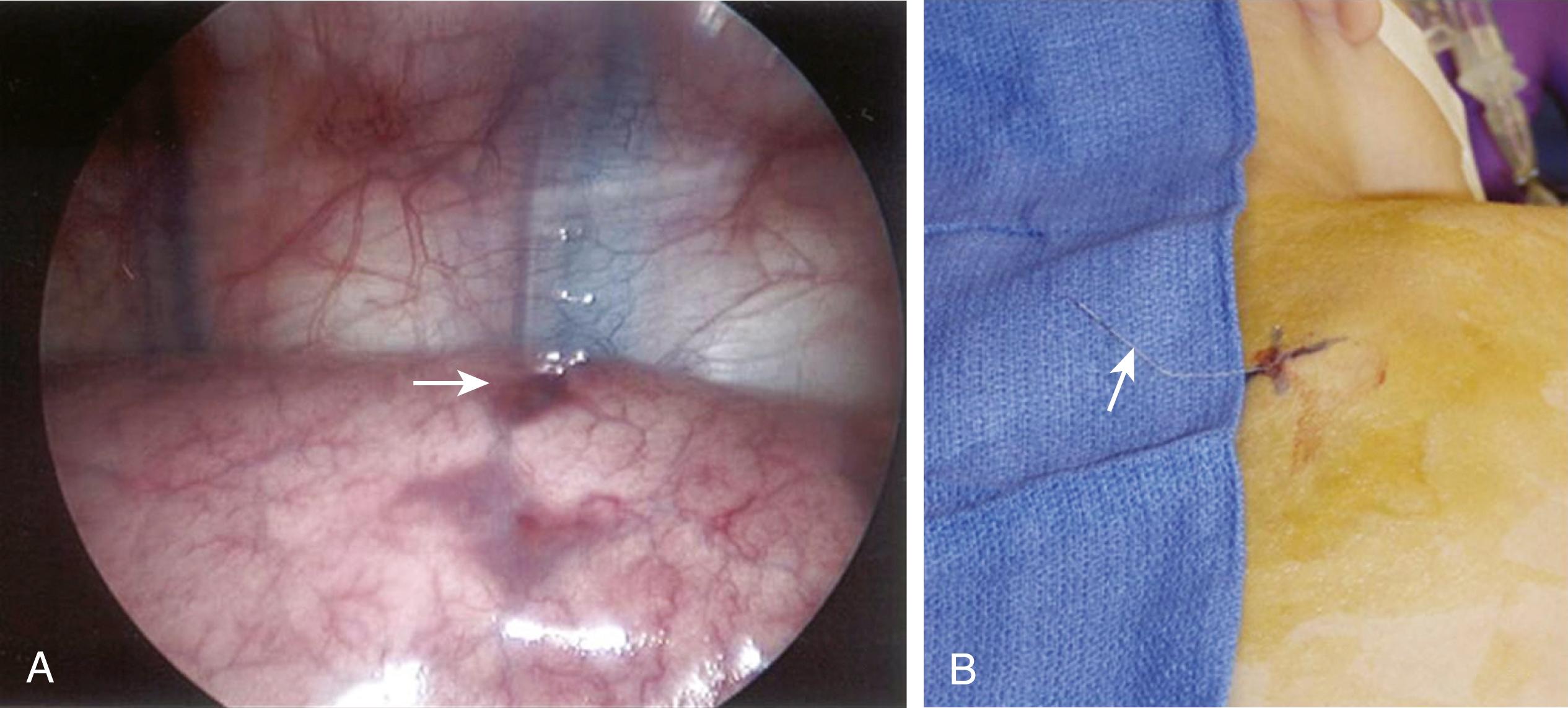
If possible, single-lung ventilation is advised to aid in collapsing the lung to be biopsied. This is usually accomplished by performing a mainstem intubation of the contralateral side (see Chapter 30 for additional information). Alternatively, a 3 or 4 Fr Fogarty balloon catheter can be inserted through the vocal cords at the time the patient is intubated with a single-lumen endotracheal tube. A fiberoptic bronchoscope is then passed through the endotracheal tube, and the blocker is guided into the ipsilateral mainstem bronchial orifice under direct vision. The surgeon should be present during this part of the anesthetic introduction to assist the anesthesiologist with placement of the blocker and to confirm its correct location. The patient is then positioned in a lateral decubitus position ( Fig. 31-2 ). The chest is first insufflated with CO 2 at a low flow (1 L/min) and low pressure (4 mm Hg) using a Veress needle in the midaxillary line in the fifth intercostal space. This helps collapse the lung and prevent inadvertent parenchymal injury with insertion of the first cannula. In all cases, valved ports should be used to allow continuation of the CO 2 insufflation to help keep the lung collapsed as there is often mild overflow ventilation from the contralateral lung.
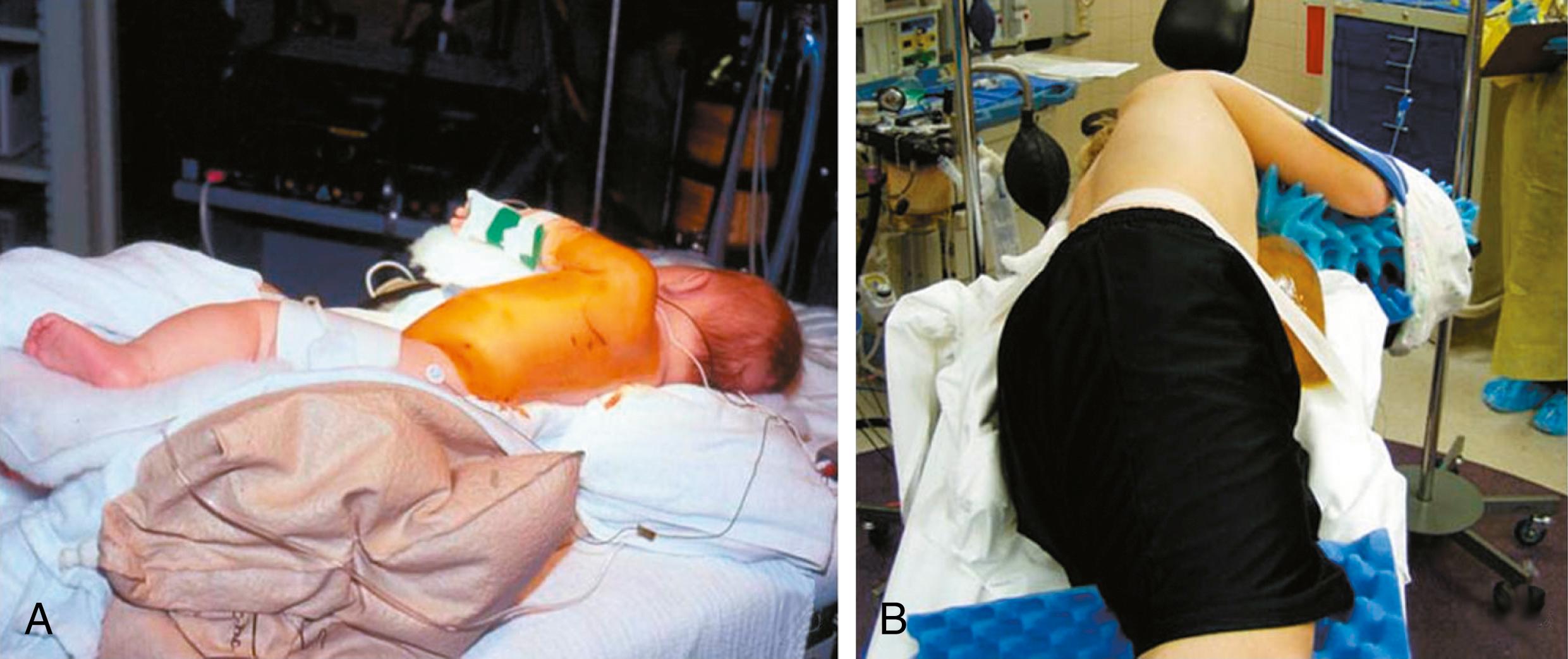
Three ports are usually needed and many lesions can be approached by placement of one port in the lower midaxillary line, one high in the axilla, and the final port in the parascapular line ( Fig. 31-3 ). This configuration can be modified depending on the location of the target lesion or lesions. For instance, if the nodule is more posterior, the patient is positioned more prone and the ports positioned more posteriorly. The initial cannula is situated in the midaxillary line to allow a survey of the entire lung surface. The other two cannulas are sited to facilitate resection of the desired tissue, usually one port anteriorly to grasp the desired tissue and the third site posteriorly in the largest interspace possible for insertion of the endoscopic stapler and removal of the specimen. If necessary, the largest port can be removed and the stapler introduced directly through the chest wall ( Fig. 31-4 ).
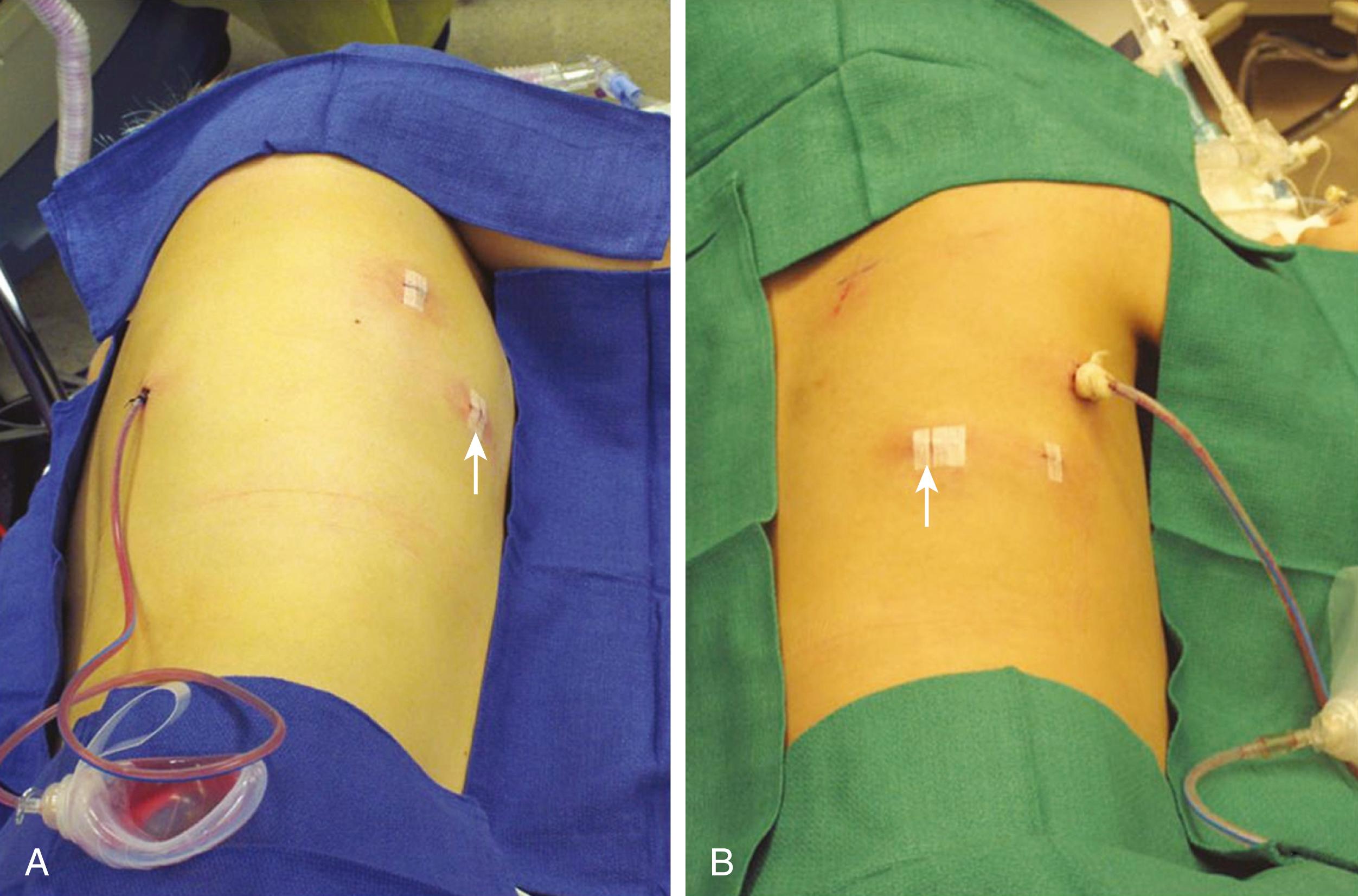
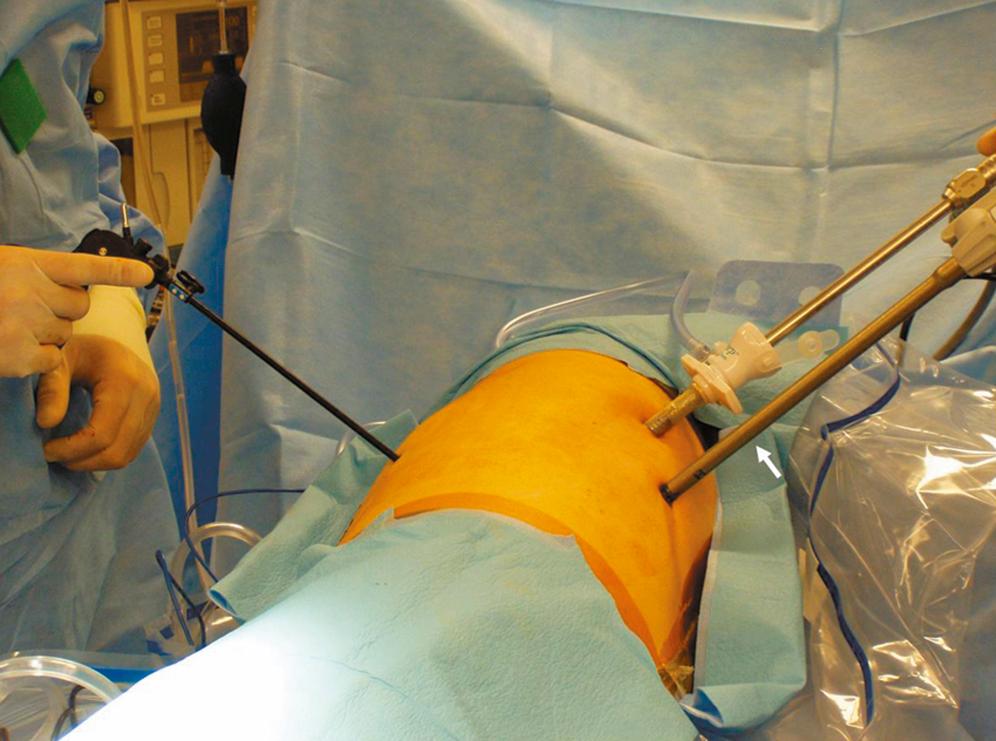
In patients over 15 kg, two 5-mm ports and one 12-mm port are used to allow access for the 12-mm endoscopic stapler. The desired tissue is placed on stretch and the stapler is positioned across the base of the desired specimen and fired ( Fig. 31-5 ). Usually, more than one application is necessary to complete the excision. If malignancy is not suspected, biopsy specimens are then exteriorized through the cannula or cannula site. In cases of presumed malignant lesions, the specimen can be exteriorized through the cannula, or if too large, the specimen is placed into an endoscopic specimen bag and brought out through the cannula tract to prevent contamination of the port site ( Fig. 31-6 ).

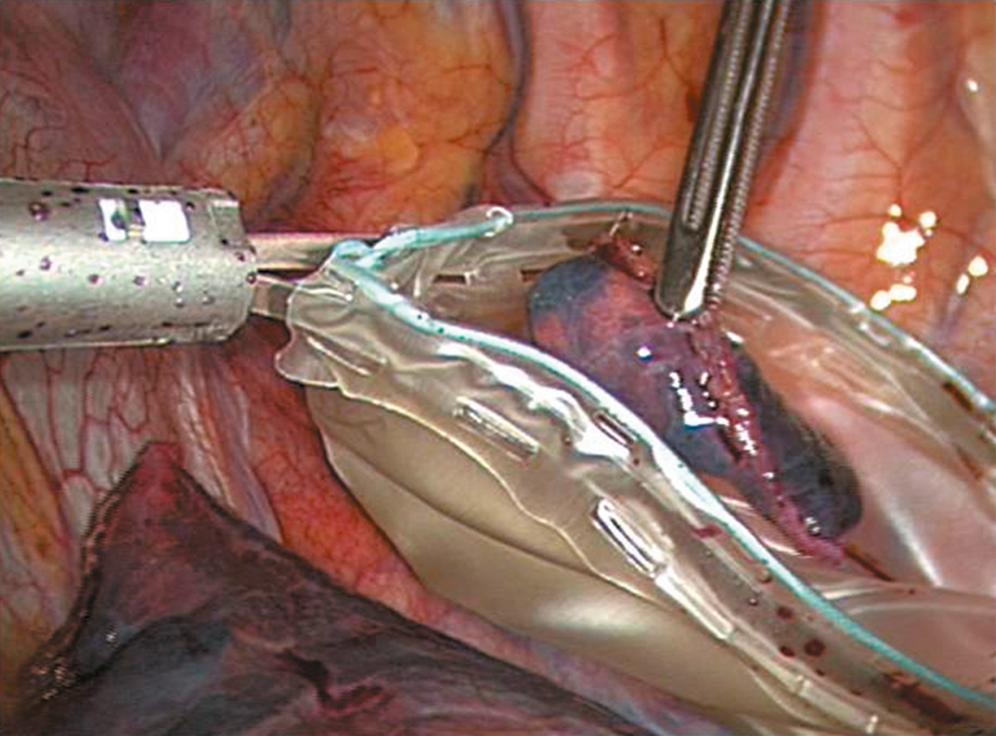
For infants and smaller children, there are now two options. The first is to use the 5-mm endoscopic stapler (Bolder Surgical, Louisville, CO) in the same fashion as described for larger children ( Fig. 31-7 ). If this device is not available, endoloops can be used. The telescope is inserted in the superior port and a grasping forceps is introduced in the anterior port. The tongue of lung tissue to be biopsied is grasped and elevated ( Fig. 31-8A ). Two endoloops are sequentially placed over the tissue, snaring the base of the specimen ( Fig. 31-8B ). The specimen is then resected distal to the loops using scissors ( Fig. 31-8C ).
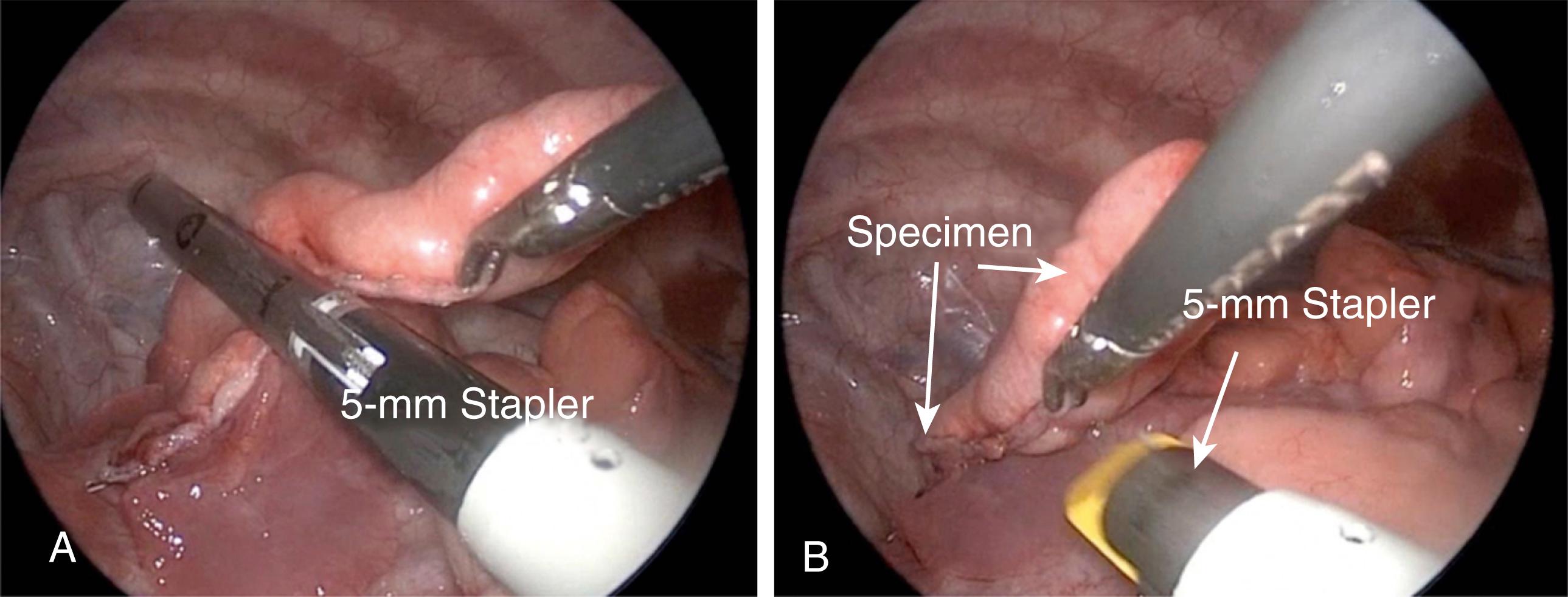

After resection, a chest tube or drain is inserted through one of the port sites (see Fig. 31-3 ), and the other incisions are closed. The patient is positioned supine and the endotracheal tube is withdrawn into the trachea. The collapsed lung is re-expanded, and the chest tube or drain is placed to water seal. If there is no evidence of an air leak (the finding in the majority of cases), the chest tube or drain can be removed and an occlusive dressing applied before extubating the patient. Removal of the chest tube before leaving the operating room eliminates a significant amount of postoperative pain.
Become a Clinical Tree membership for Full access and enjoy Unlimited articles
If you are a member. Log in here